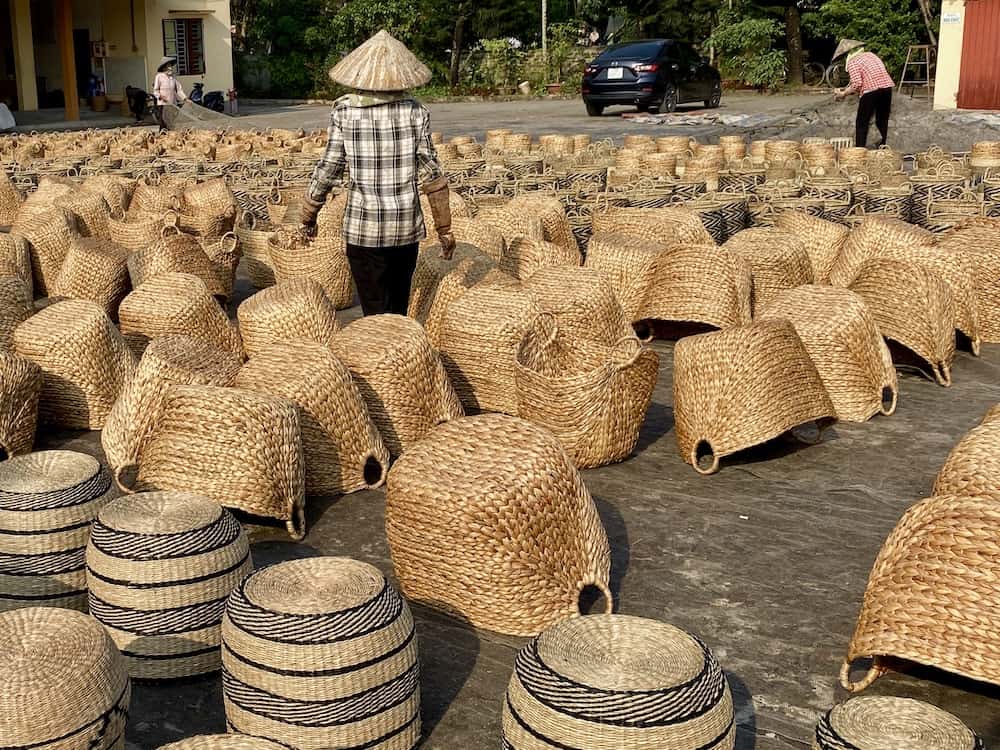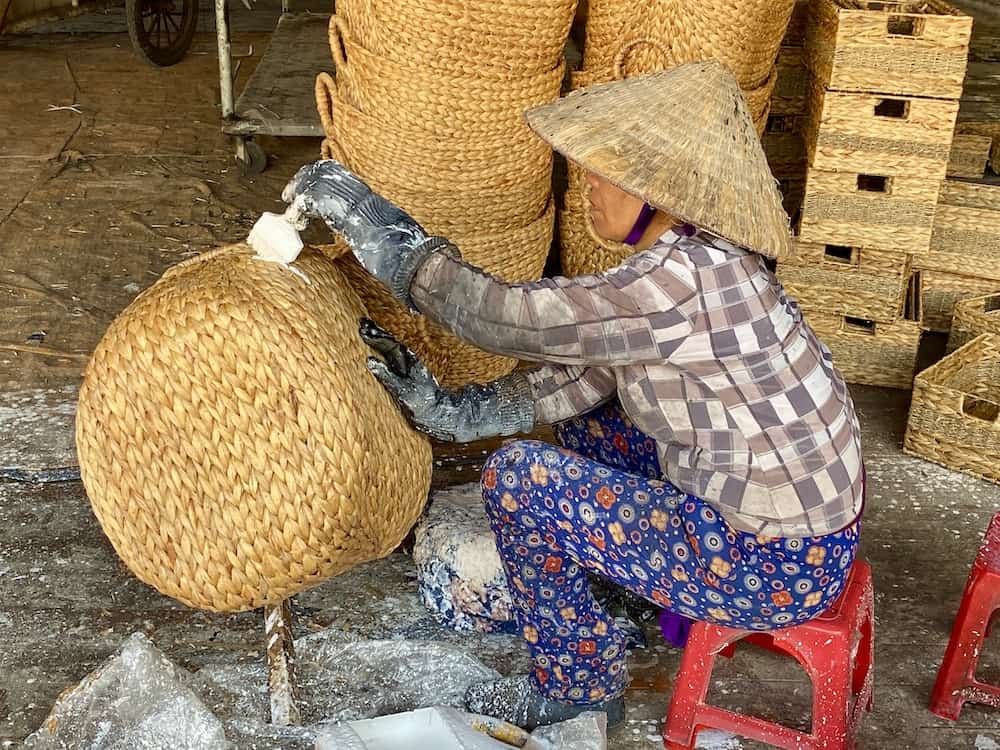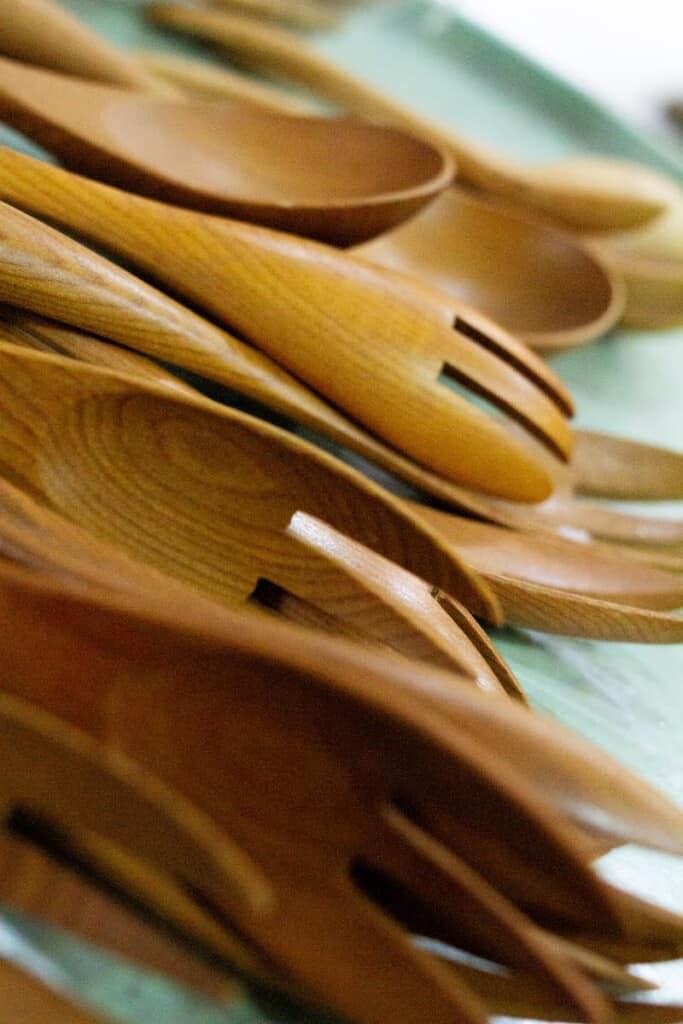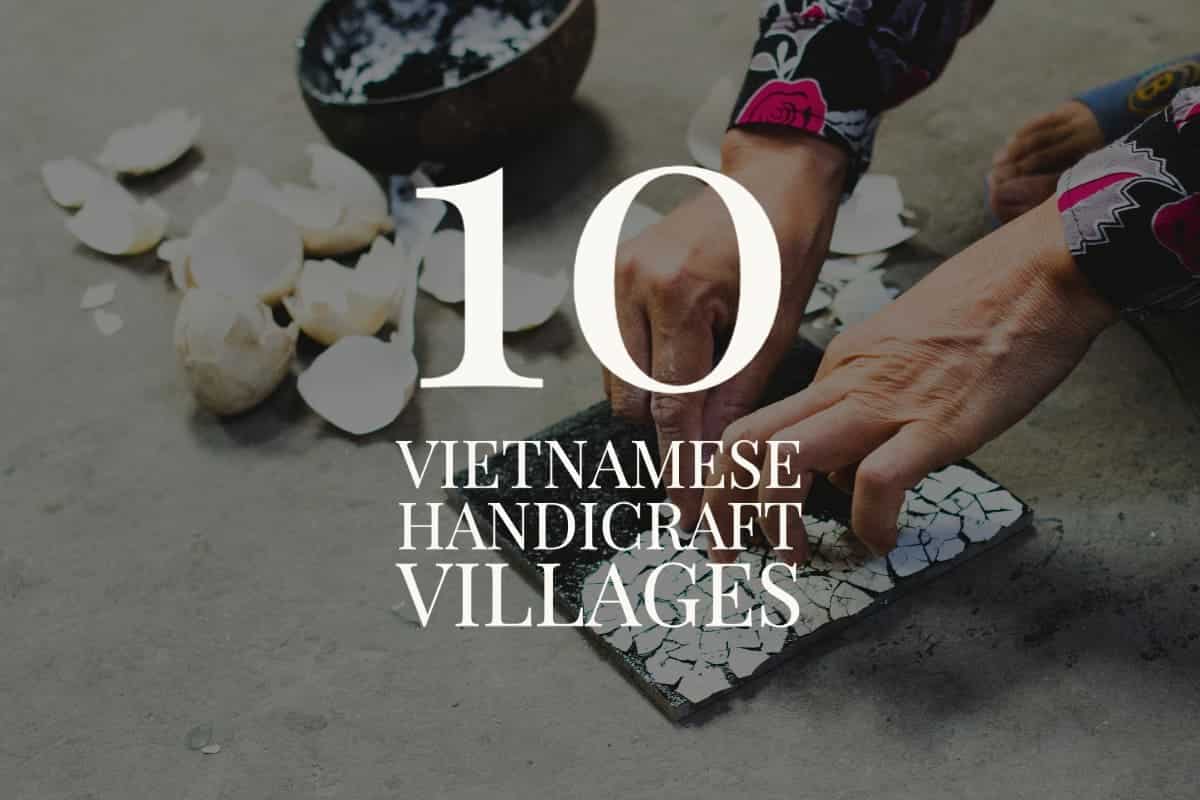It has always fascinated me as to why Mao, the father of Communist China, set out to destroy many of the traditional Chinese handicraft villages, and Ho Chi Minh, the father of the Socialist Republic of Vietnam, did not. At one time, both countries had similar ideologies, but how they dealt with the cultural handicraft villages was completely different. Through all their years of wars and destruction, one thing that remained intact in Vietnam was the handicraft village culture.
Today 10 Vietnamese handicraft villages are still manufacturing many of the same products they have produced for hundreds if not thousands of years. Some of these villages include Bat Trang Ceramic Village, Duyen Thai Lacquer Village, Quat Dong Embroidery Village, Van Phuc Silk Village, Kim Son Sea Grass Village, Ninh Binh Water Hyacinth Villages, Chuong My Rattan Village, Thuong Tinh Horn Village, Thanh Oai Conical Hat Village, and Xuan Lai Bamboo Village.
Table of Contents
- Exploring Vietnam’s 10 Prestigious Handicraft Villages
- Vietnam Handicraft – Bat Trang Ceramic Village
- Vietnam Handicraft – Duyen Thai Lacquer Village
- Vietnam Handicraft – Quat Dong Embroidery Village
- Vietnam Handicraft – Van Phuc Silk Village
- Vietnam Handicraft – Kim Son Seagrass Village
- Vietnam Handicraft – Ninh Binh Weaving Villages
- Vietnam Handicraft – Chuong My Rattan Village
- Vietnam Handicraft – Thuong Tin Horn Village
- Vietnam Handicraft – Thanh Oai Conical Hats Village
- Vietnam Handicraft – Xuan Lai Bamboo Village
- Related Questions
Exploring Vietnam’s 10 Prestigious Handicraft Villages
Vietnam is home to many handicraft villages, ten of which stand out for their enduring artistry and traditional manufacturing techniques honed over centuries. These include the renowned Bat Trang Ceramic Village, Duyen Thai Lacquer Village, and Quat Dong Embroidery Village, including Van Phuc Silk Village and Kim Son Sea Grass Village.
Each village, with its unique craft, reflects a rich cultural heritage that has withstood the test of time, including the tumultuous periods of war, particularly in Northern Vietnam. Today, these villages not only preserve their traditional crafts but continue to thrive, showcasing the resilience and enduring spirit of Vietnamese craftsmanship.”
We love these handicraft villages as, despite all the years of war that Vietnam went through, especially in the north, these villages remained intact, and people are still manufacturing in them even today.
Traditionally many of the people in the villages would marry someone from the village. So that means that many of the households that are manufacturing the products are somehow related. This feeling of having your family as your competitor also helps to ensure that when they have a large-scale order that they need help with, they can find other family members in the village who are able to help them with this production.
Many of these villages we have listed below do not give tours as they are mainly manufacturing locations as that produce products for the local and export markets.

Vietnam Handicraft – Bat Trang Ceramic Village
When you speak about Vietnamese ceramics, most people think about Bat Trang the ancient pottery village that is located just outside Hanoi, Vietnam. Today many of these same families who have been producing ceramics and pottery for a thousand years continue to produce and sell their pottery wares.
The Bat Trang ceramic village has a very interesting history. If you are interested in finding out more about the Bat Trang ceramic villages, you can read our blog, Vietnam’s Bat Trang Ceramic Village History, by clicking here.
Vietnam Handicraft – Duyen Thai Lacquer Village
Lacquer continues to be a major handicraft manufacturing product that is still produced mainly in lacquer villages. The main lacquer village that most people visit is in Duyen Thai. There is also another village a bit further outside Hanoi than Duyen Thai, called Phu Xuyen
Both of these villages have been producing lacquer products for many years. Their main production includes lacquer, eggshell, and mother-of-pearl finishes.
If you want to find out more about lacquer or the mother of pearl you can read our blogs on How to Manufacture Vietnamese Lacquerware? by clicking here.

Vietnam Handicraft – Quat Dong Embroidery Village
Outside Hanoi is Quat Dong the traditional embroidery village. This village is where hand embroidery products are being manufactured in Vietnam. Today some of the small workshops have brought in embroidery machines, but many of the people in the village are still using the silk embroidery threads to embroider 100% by hand as they have for over 700 years.
Vietnam is known for its very intricate handmade embroidery art. The embroidery is so fine that it looks like an oil painting. They also embroidered their traditional Vietnamese Ao Dai’s, scarves, beddings, tablecloths, and other items.
Vietnam Handicraft – Van Phuc Silk Village
The Van Phuc Silk Village is located just outside downtown Hanoi. It is a traditional village that has been producing silk for over 100 years. The French came and taught the Vietnamese to use their old wooden handlooms and to add a motor and punch card on them so that they could produce beautiful Jacquard woven designs.
Today you can go into the village and see these interesting machines clicking away as they manufacture silk. There is also a lot of small shops selling all kinds of silk products.
I have found that not all the silk they produce is 100% silk. Some of it is mixed with polyester threads. So, if you really want to have a 100% silk item, you may need to check the silk you are purchasing by burning it. Real silk will burn like paper, whereas polyester when burned will leave small plastic-like bubbles.

Vietnam Handicraft – Kim Son Seagrass Village
Vietnam produces a lot of seagrass products. This is because they have a lot of seagrasses in their salt waters. Several villages outside Hanoi do various kinds of handicraft weaving. Today, they are weaving mainly baskets and other home decor handicraft items.
One of the things we love about this kind of production is that it is produced mainly in the village by women. The women will weave the baskets at home while still being able to run a small farm and take care of their children. The weaving of baskets and other items helps them to supplement their income.
You can read more about seagrass production by reading our blog Eco-Friendly Seagrass Materials Used in Home Decor Products by clicking here.
Vietnam Handicraft – Ninh Binh Weaving Villages
Ninh Binh is also outside Hanoi and has a lot of production of water hyacinth and also seagrass handicraft weaving. This is in part due to the fact they have many trained weavers and raw materials.
This area will weave everything from rugs to baskets to lamp bases and even small pieces of furniture. Anything that can be woven with seagrass and water hyacinth they will weave.
You can find out more by reading our blog About Weaving Water Hyacinth Baskets Into Home Décor Products by clicking here.

Vietnam Handicraft – Chuong My Rattan Village
Also located outside Hanoi Is a village that has been producing rattan for over 200 years or more years. Like many of the other handicraft villages, almost all the households are producing some form of rattan products.
Everyone in the village knows how to weave rattan – the young, the women, the men, and the older people. Everyone can somehow contribute to the manufacturing of rattan products.
To learn more about rattan production in Vietnam, you can read our blog called What is The Rattan Material Used in Home Decor Products? by clicking here.
Vietnam Handicraft – Thuong Tin Horn Village
Thuong Tin is another small village located outside Hanoi. They produce mainly horn jewelry, small wooden beads, and other small wooden items. They use some local buffalo horns but also import some very nice horns from other places such as Africa.
They have cutting and polishing machines that allow them to cut the horn in various shapes and sizes. Like most handicrafts villages, this village has been making horn products for hundreds of years. Traditionally horns and wood were used to make serving utensils like spoons, forks, chopsticks, and home decor items.

Vietnam Handicraft – Thanh Oai Conical Hats Village
The Thanh Oai Conical hat village is well-known for its Vietnamese-style palm leaf hats which are called ‘non” in Vietnamese. Like most handicrafts villages almost everyone in the village knows how to make these famous Vietnamese hats.
Every day in this village the village people will gather in their homes or under the trees to make these famous palm leaf hats. This is one of these villages that are continuing to make a product that many in Vietnam continue to use formally and also today. Almost every household in Vietnam will have at least one if not several of these hats.
Vietnam Handicraft – Xuan Lai Bamboo Village
The Xuan Lai bamboo village produces all kinds of bamboo, but this village will mainly produce bamboo furniture. This village also produces smoked bamboo so as to give the bamboo a brown color.
Many Vietnamese like to have some bamboo furniture items in their homes. This is because bamboo is considered a very good and lucky symbol. If you want to find out more about bamboo for your home, you can read our blog on Bamboo – An Auspicious Plant For Your Home by clicking here.
One of the great things about Vietnam is that many of these villages have been producing and manufacturing these products for many years. The small workshops that produce these items have skills they have spent a lifetime learning, so they are able to produce some top-quality and unique products.
If you are interested in finding out more about manufacturing some products for these traditional villages outside Hanoi, Mondoro would love to help you with this. Please feel free to contact Anita by clicking here.
Find out more about how Mondoro can help you create, develop, and manufacture excellent home decor and furniture products – don’t hesitate to contact me, Anita. Check out my email by clicking here or become a part of our community and join our newsletter by clicking here.
Mondoro gives out a FREE Lookbook to anyone interested. You can receive a copy of our latest Lookbook by clicking here.
Listen to our Podcast called Mondoro Company Limited. You can find it on all major podcast platforms. Try out listening to one of our podcasts by clicking here.
Subscribe to our Mondoro Company Limited YouTube Channel filled with great videos and information by clicking here.
Related Questions
What is Gold Leafing Used in Home Decor Products?
Gold leaf is hammered gold. Some gold leaf manufactured today is actually hammered, copper or gold mixed with other metals and alloys. The gold leaf is manufactured by gold beating. Gold beating is to beat or press the gold into extremely thin sheets of paper. This gold-beating technique was discovered over 5,000 years ago. Today, there are many wonderful uses for the gold leaf finish for home decor and home furniture product development.
You can find out more by reading our blog What is Gold Leafing Used in Home Decor Products? by clicking here.
What is the PVD Stainless Steel Coating Used On Home Decor Products?
PVD coatings are a very thin, yet highly durable coating that can be placed on many different kinds of substrates, including stainless steel. A vacuum chamber with very high temperatures is used to apply the PVD coating. Though this finish is used a lot in the tech, medical, and aerospace industries, it is also used for home decor and home furniture products.
You can discover more about PVD by reading our blog What is the PVD Stainless Steel Coating Used On Home Decor Products? by clicking here.

